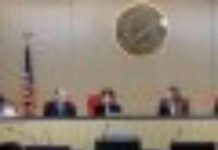Gov. Gavin Newsom’s plea to the U.S. Federal Emergency Management Agency (FEMA) to conduct soil testing post-cleanup for the Los Angeles County wildfires faced a resounding rejection on Wednesday. Despite federal contractors diligently removing wildfire debris and a 6-inch layer of topsoil from the properties ravaged by the Eaton and Palisades fires, FEMA stood firm on its decision to skip soil testing—a decision that has sparked concerns among California officials and residents about potential soil contaminants lingering in the aftermath of the fires.
Nancy Ward, the director of California’s Office of Emergency Services, penned a compelling letter to FEMA on Wednesday, emphasizing the critical role of soil testing in safeguarding returning residents, construction workers, and the environment from post-fire contaminants. The plea highlighted the potential risks posed by undetected toxic chemicals in the soil and underscored the importance of identifying and remediating fire-related contaminants to prevent long-term environmental and health hazards.
A Disagreement Emerges
Ward’s letter to FEMA’s federal coordinating officer Curtis Brown marked the first sign of displeasure from California officials regarding the federal cleanup strategy. As federal cleanup crews celebrated the completion of the initial cleanup of a property in the Palisades fire, the exchange of letters between state and federal authorities shed light on the contrasting perspectives on soil testing.
In response to Ward’s call for soil testing, Brown expressed concerns over the potential delays and added costs associated with the additional testing. He emphasized that while FEMA would not impede state, local governments, or individual property owners from conducting soil testing at their discretion, the agency would only reimburse the costs if the testing results clearly linked positive outcomes to the fires.
The disagreement between state and federal authorities underscored the delicate balance between expeditious cleanup efforts and the need for comprehensive soil testing to ensure the safety and well-being of communities affected by the wildfires. While FEMA defended its decision to streamline the cleanup process and prioritize speed and efficiency, California officials remained steadfast in their commitment to thorough soil sampling as a critical component of the recovery and rebuilding efforts.
A History of Soil Sampling
The ongoing debate surrounding soil testing post-wildfire cleanup in California has deep roots in past wildfire responses, where federal or state officials have mandated soil sampling as a precautionary measure to address potential contamination risks. The practice, which aims to prevent residents from returning to hazardous conditions, has been a longstanding protocol in major wildfire cleanup operations.
Notably, during the cleanup of the 2018 Camp fire, significant findings emerged indicating that a substantial number of properties still harbored toxic chemicals exceeding California’s cleanup standards even after the removal of 3 to 6 inches of topsoil. This revelation prompted additional soil removal and follow-up testing to rectify the lingering contamination, highlighting the necessity of thorough soil sampling in post-fire cleanup operations.
Ward’s letter emphasized the extensive reach of wildfire-related contamination, highlighting the inadequacy of limiting soil testing to a 6-inch depth. Citing past sampling data, Ward reiterated the importance of comprehensive soil testing in identifying and addressing contaminants that may extend beyond the superficial layers of soil. However, FEMA’s response, as articulated by Brown, reiterated the agency’s stance on prioritizing expediency and efficiency in the cleanup process, despite the concerns raised by California officials about the potential risks posed by inadequate soil testing practices.
As the debate continues to unfold between state and federal authorities, the fate of soil testing in the aftermath of the Los Angeles County wildfires remains uncertain. While both sides are committed to the common goal of facilitating a swift recovery and rebuilding process, the divergent perspectives on soil testing underscore the complex challenges and trade-offs inherent in disaster response and recovery efforts.
The implications of this disagreement extend far beyond the immediate cleanup operations, shaping the future landscape of disaster response policies and practices in California and beyond. As communities grapple with the aftermath of devastating wildfires, the debate over soil testing serves as a poignant reminder of the delicate balance between expediency and diligence in safeguarding public health and environmental well-being.




